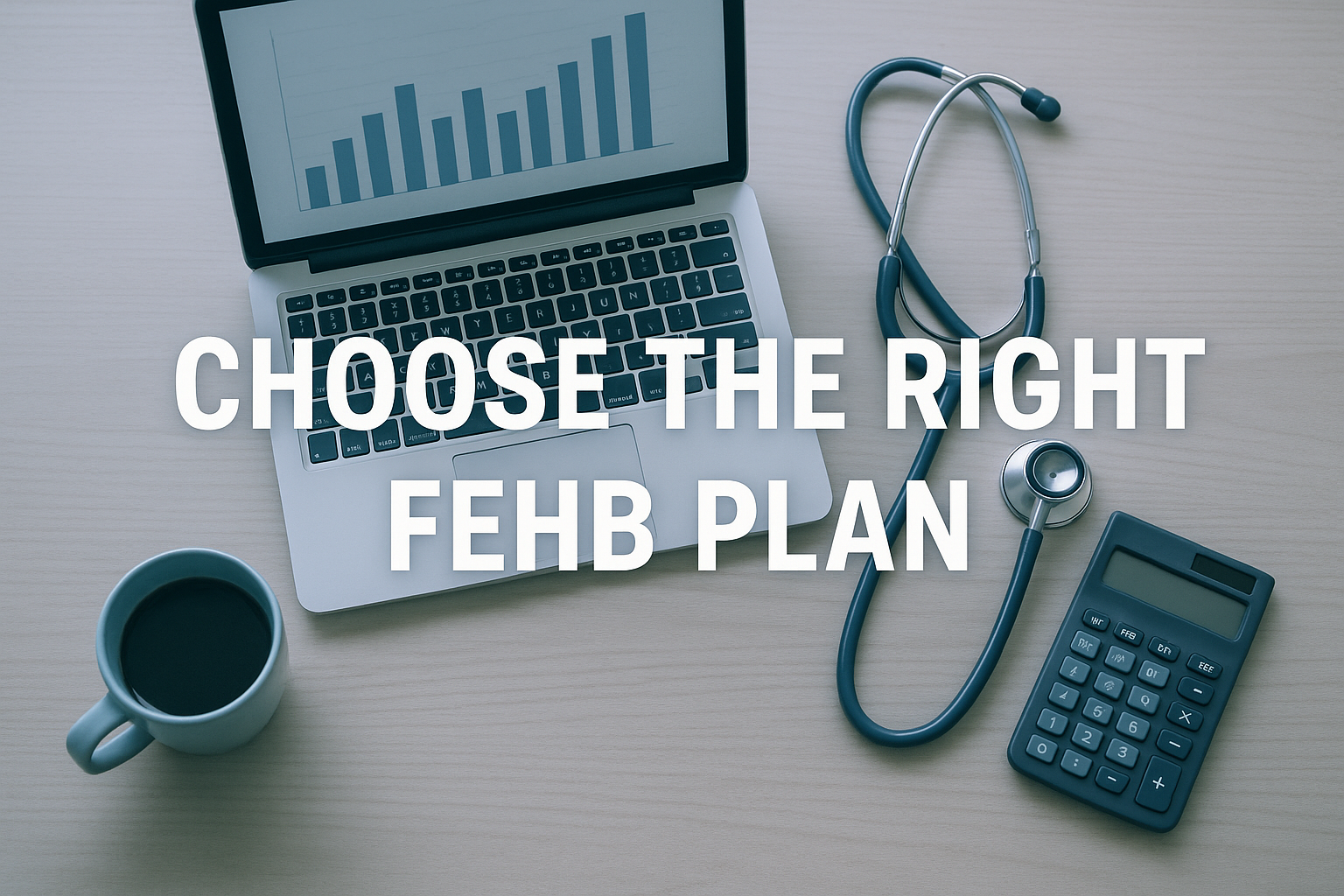How to Choose the Right FEHB Plan for Your Federal Health Coverage
When it comes to making decisions about your federal health insurance benefits in retirement, the stakes are higher than ever. Rising premiums, shifting Medicare coordination rules, and the intricate interplay between FEHB and Medicare Part B can leave many federal employees uncertain about which direction to take. Yet choosing the right plan isn’t simply about picking the cheapest option. From out-of-pocket maximums to prescription drug coverage, every detail matters. And that’s why, with our Fed-Expert Financial Blueprint process, we help federal employees and retirees more confidently navigate these complex choices. In this post, we’ll walk through the most pressing issues around your 2025 FEHB enrollment—so you can be sure you’re protecting both your health and your wallet.
The High-Stakes Decision Behind Your 2025 FEHB Enrollment
Why is this year’s Open Season so crucial for federal employees and retirees? For starters, FEHB premiums are set to increase by an average of 13.5% in 2025. (See our deep dive on the 2025 FEHB premium hike.) This spike is more than double some prior annual increases, and it’s far from uniform across all plans. While some plans will see decreases or no change at all, many will jump significantly. In fact, at least one regional HMO is raising its premiums by more than 50%, which can add thousands to your health-care tab if you’re not paying attention.
Yet cost isn’t the only factor. Many retirees are reevaluating how their FEHB plan coordinates with Medicare. Whether you’re continuing to work past age 65 or you’ve already retired, knowing how FEHB interacts with Medicare Parts A & B can be a game-changer. When you choose a plan that aligns poorly with your Medicare scenario—or ignore Medicare altogether—you could end up overpaying every year or leaving critical gaps in coverage. Done right, though, you can avoid wasteful double coverage and often reduce your total out-of-pocket exposure. That’s why planning now could save you thousands over the course of your retirement.
If you do nothing during this fall’s Open Season, you’re gambling with these new premium hikes. Although staying put might feel comfortable or convenient, you may be missing out on plans that present far better value. Some folks discover too late that their premiums have skyrocketed while deductibles also inched upward. Others may find themselves in a plan that looked economical at inception but becomes too restrictive down the road. We want you to feel confident that the plan you select is truly right for both your budget and your health-care needs.
FEHB 101: How Your Federal Health Insurance Benefits Really Work
Even longtime federal employees can benefit from a refresher on how FEHB is structured, especially since the transition into retirement changes the premium dynamic. As an active federal employee, your agency typically covers about 72% of the weighted-average premium—capped at 75% of your specific plan’s cost. Once you retire, your employer stops contributing payroll-based funds, but the U.S. Office of Personnel Management (OPM) continues covering its share of your premium from your annuity if you maintain FEHB.
FEHB eligibility embraces current employees, most annuitants, and even certain survivors, as long as the federal worker was enrolled in FEHB for at least the last five consecutive years before retirement. Coverage tiers range from Self Only to Self Plus One and Self & Family. But one quirk that surprises many is that Self Plus One can sometimes cost more than Self & Family, depending on the specific plan. Factors like age-based premium structures and plan pricing quirks can create these counterintuitive scenarios, so it’s never safe to assume the smaller coverage tier is automatically cheaper.
For those wondering whether your premium doubles (or even more) as soon as you retire, rest assured the government still contributes toward your FEHB in retirement—just not through a direct payroll mechanism. It’s also important to note that your spouse may remain on your FEHB if you elect the appropriate survivor and family coverage. If you pass away first, and you have maintained Self & Family or Self Plus One coverage while ensuring your spouse qualifies for a survivor annuity, they can keep FEHB. (You can learn more in our article on continuing FEHB as a survivor annuitant.)
Here’s a quick glance at how Self Plus One can sometimes stack up against Self & Family in certain plans:
| Plan | Self Plus One Bi-Weekly Premium | Self & Family Bi-Weekly Premium |
|---|---|---|
| Plan A | $300 | $295 |
| Plan B | $350 | $365 |
Although Plan A’s Self Plus One looks more expensive than Self & Family, Plan B’s reversed scenario shows that each plan can vary, underscoring why a thorough look at benefits is paramount.
The Four Cost Levers to Compare Before You Click Enroll
Most of us naturally focus on the monthly or bi-weekly premium when comparing health plans. But premium alone isn’t the entire cost picture—other levers can ultimately push your spending higher. If you require frequent doctor visits or specialized therapies, your out-of-pocket costs, deductibles, and coinsurance could exceed any premium savings you noticed at first glance. Meanwhile, catastrophic caps, specialty drug costs, and provider network constraints can also have enormous financial implications if you experience a serious health event.
To truly gauge your annual health-care spend, you’ll need to factor in these four levers:
1. Premium – the most visible cost, but not always the biggest component.
2. Deductible – what you pay before the plan kicks in. High-deductible plans may look cheaper until you factor in certain ongoing visits or prescriptions.
3. Copays & Coinsurance – each plan structures these differently. Some charge a low flat rate for primary care but higher rates for specialists.
4. Out-of-Pocket Maximum – your true backstop if you face serious illness. Plans with low maximums can protect you from catastrophic bills.
Consider how these can stack up differently under varying usage levels. Let’s illustrate with an example using two usage scenarios—“Low Usage” for individuals who mostly just see a doctor for preventive checkups and minimal prescriptions, and “Moderate Usage” for those who see specialists occasionally and fill monthly prescriptions.
| Plan | Annual Premium (Self+1) | Low Usage (2 PCP, 4 Rx) | Moderate Usage (8 PCP, 2 Specialist, 12 Rx) | Projected Total Cost Low | Projected Total Cost Moderate |
|---|---|---|---|---|---|
| Blue Basic | $2,800 | $150 | $600 | $2,950 | $3,400 |
| GEHA Standard | $2,500 | $200 | $700 | $2,700 | $3,200 |
| Regional HMO | $3,200 | $100 | $550 | $3,300 | $3,750 |
While the HMO in this example shows a lower out-of-pocket for moderate usage, its premium is higher—making total costs more expensive for healthy enrollees. GEHA Standard, on the other hand, might come out cheaper if you anticipate fewer specialist visits, but families who might use more services might find Blue Basic’s structure more appealing. The point is to balance all these elements, not just the monthly premium, before selecting the plan that’s best for you.
Approaching 65? FEHB and Medicare Coordination Explained
For federal employees or retirees in their early 60s, understanding how FEHB interacts with Medicare can be as pivotal as any other aspect of your retirement planning. Typically, Medicare becomes the primary payer once you enroll, while FEHB steps back to secondary coverage. This means FEHB may waive most of your cost-sharing—deductibles, copays, and coinsurance—if you have both Part A and Part B. In such scenarios, your overall costs can drop dramatically, especially in a plan that specifically aligns well with Medicare, such as certain FEP Blue plans or specific GEHA plan options.
But at the same time, Medicare Part B isn’t free—and for many retirees, the $185.00 monthly premium in 2025 can feel steep. That’s why some FEHB plans now offer partial Part B premium reimbursement (often up to $800 a year—and as high as $1,000 in a few plans) as an incentive. This is a growing trend, particularly under “Medicare Advantage” or Employer Group Waiver Plans that integrate FEHB and Medicare coverage more closely. If you’re weighing whether to elect Medicare Part B, take a careful look at plans that offer these reimbursements, because they can slice hundreds off your annual out-of-pocket. Of course, if your income is above certain thresholds, IRMAA surcharges could add even more complexity to your Part B decision, so you’ll want an integrated approach that factors in taxes, withholding, and IRMAA adjustments.
| Plan | Part B Reimbursement | Does Plan Waive Deductible/Copays when Medicare is Primary? | Requires Part B Enrollment? |
|---|---|---|---|
| FEP Blue Basic | Up to $800/year | Yes | Yes, to get the incentive |
| GEHA Standard | $0 | Yes | No, but benefits improve with B |
| GEHA HDHP | None | Partial Waiver | No, but benefits improve with B |
Do you have to enroll in Part B? Strictly speaking, no—you won’t lose FEHB if you decide not to. But you’ll continue paying your plan’s normal cost-share. In the worst case, that might mean higher deductibles or coinsurance than you’d prefer in retirement. On the flip side, if you do choose Part B, you’ll need to gauge whether the combined premium of FEHB + Part B is worth it, especially if you’re subject to IRMAA. The silver lining is that some plans reduce costs or even reimburse part of your Part B premium, which can tip the scales toward enrolling.
Myth-Busting: “I Can Drop FEHB Once I’m on Medicare”
One rumor that floats around is that Medicare alone is sufficient in retirement, so you can safely cancel FEHB. That’s rarely a wise move. FEHB covers prescription drugs, foreign travel emergencies, and other costs that Medicare might not fully cover. And once you cancel FEHB voluntarily, you generally cannot re-enroll later. While it may appear cheaper in the short term to rely solely on Medicare, most experts advise at least maintaining FEHB at some level for its comprehensive coverage and the freedom to switch plans each year. Remember, suspending FEHB for something like TRICARE For Life—see how military retirees can suspend instead of cancel—might be possible, but canceling outright is a one-way door.
2025 Plan Snapshots: Comparing the Most-Chosen FEHB Options
With so many FEHB plans out there, navigating each brochure can become a full-time job of its own. Below, let’s look at the marquee plans people consistently gravitate toward, along with one or two regionals that might surprise you—especially if you’re open to an HMO. Your personal needs matter a great deal: while an HDHP with a Health Savings Account (HSA) might bring big tax benefits for those with low medical usage, it may not be ideal if you anticipate frequent doctor visits in the near future. (If you’re considering an HDHP, don’t miss our primer on high-deductible health plans for federal employees.)
Here’s a quick snapshot of some of the notable premium changes. You’ll see exactly why it pays to shop around:
| Plan (Code) | Coverage Type | 2024 Bi-Weekly Premium | 2025 Bi-Weekly Premium | % Change | Dollar Change / Year |
|---|---|---|---|---|---|
| Presbyterian PS | Self Only | $118.43 | $91.07 | –23% | –$711 |
| CareFirst B6 | Self Only | $109.74 | $109.74 | 0% | $0 |
| Health Alliance K8 | Self Only | $67.16 | $111.47 | +66% | +$1,152 |
Plans like the FEP Blue Focus keep premiums lower than Blue Standard or Basic, but you’ll see in-network restrictions and a deductible. Meanwhile, GEHA’s Elevate is often praised for its nominal copays and competitive premiums, though it may require careful attention to how it coordinates with Medicare if you’re close to 65. GEHA HDHP can be a strategic pick for near-retirees who want to take advantage of HSA contributions—particularly if they’re still working, since individuals age 55 and older can contribute an extra $1,000 HSA catch-up each year, further boosting those tax benefits.
Tools & Tactics to Fine-Tune Your Short List
Between the OPM comparison tool, Checkbook’s Guide, and carrier brochures, you have a wealth of information at your fingertips—but it’s a lot to digest. The OPM Plan Comparison Tool works best when you carefully enter your zip code, employee type, and coverage needs. Watch out for zip-code quirks, though: some plans have limited service areas or different rates by region, so always verify whether the plan you’re eyeing covers your location.
Checkbook’s Guide to Health Plans offers a deeper dive that factors in Medicare toggles, letting you compare how your costs might differ if you opt for Part B. It also provides personalized estimates for how many times you might see a doctor, fill prescriptions, or need lab work, then shows your expected spending. That level of analysis uncovers nuanced differences that simple side-by-side premium comparisons often miss.
Sometimes, the biggest driver for a switch isn’t the premium but whether your provider is in the plan’s network, or whether a certain prescription is covered at a higher tier. One 61-year-old DHS employee we worked with found that her Blue Standard plan’s specialist copay and brand-name drug tiers were costing her about $1,400 more a year than she realized. After reviewing her usage pattern, she switched to GEHA Standard—lower premium, reasonable deductibles, and better prescription tiers for her medications.
Step-by-Step: Making Your Election During Open Season
So, what happens when you’re ready to lock in your plan choice? First, make sure you note the Open Season window, November 11 to December 9, 2024. (For the latest details, see our 2025 FEHB Open Season guide.) Active employees typically submit changes through systems like Employee Express, EBIS, or PostalEase (if you’re postal), or MyPay (if you’re DoD). Retirees, on the other hand, file FEHB changes via OPM’s Form 2809 or sometimes through the Services Online portal, depending on OPM’s current process. After you elect a plan, watch for a confirmation notice. If something’s off, you can typically make changes again before the end of Open Season, as long as you’re still within the window.
When do new premiums take effect? If you’re an active employee, changes usually apply to your first full pay period in January. Retirees see their annuity deductions alter accordingly, but watch for a possible lag—sometimes it takes OPM an extra pay cycle or two to catch up.
Can you change your mind after December 9? Not really, unless you experience a Qualifying Life Event (QLE), such as marriage, divorce, or birth of a child. Otherwise, your FEHB election stays put for the following year. So if you need to rethink your coverage, do it before that final cutoff date.
Common Pitfalls That Sabotage Your FEHB Retirement Strategy
Making a mistake with FEHB might seem minor now, but it can have long-term consequences—especially if you let your coverage lapse or pick a plan that won’t serve you well in five years. One common error is not maintaining FEHB coverage for at least five continuous years before retirement. That five-year window is essential if you want to carry FEHB into retirement. People sometimes assume that shorter enrollment or coverage elsewhere (like TRICARE) will count, and that can cost them dearly when they exit federal service, only to discover they’re not eligible for retiree FEHB.
Another pitfall is overlooking coverage for dependents, particularly if you have an adult child with disabilities who needs continued coverage past typical dependent age limits. Make sure your plan specifically covers them; switching after a problem arises is generally more complicated.
Finally, be aware of how FEHB interacts with other programs you might have, such as TRICARE or VA coverage. For military retirees with TRICARE For Life, you typically don’t want to cancel FEHB, but you could consider suspending it. Understanding the differences between canceling and suspending is critical because one might forfeit your chance to rejoin FEHB if TRICARE no longer meets your needs.
How PlanWell’s Fed-Expert Financial Blueprint Optimizes Health & Wealth Together
We know from experience that FEHB decisions aren’t isolated. They intersect with Social Security timing, TSP withdrawal strategies, survivor benefits, and more. That’s why PlanWell’s Fed-Expert Financial Blueprint provides an integrated look at your entire federal benefits picture. With over 30 years of combined experience, our founders and team hold the highly relevant ChFEBC, CFP, and AIF designations, ensuring that the advice you receive is both fiduciary and specialized in federal benefits.
Our process starts by clarifying your goals: when you might retire, whether you expect to work part-time, how you feel about enrolling in Medicare Part B, and so on. We then weigh your options, plan by plan—factoring in not just premiums but also projected usage, out-of-pocket caps, and potential Medicare subsidies. Crucially, we keep a watchful eye on whether you need spousal coverage and how any survivor needs might factor in. Balancing it all can be challenging, but once you have a cohesive view, you’ll find it far easier to pick healthcare coverage that supports your broader lifestyle and retirement aspirations.
If you’d like a deeper look at how your health-care choices fit into a full retirement blueprint, we invite you to sign up for one of our free Federal Retirement Planning Workshops. We’ll walk you through real-world case studies, discuss TSP drawdown strategies that align with your FEHB plans, and break down how Medicare can integrate seamlessly with your future health and wealth strategy.
Conclusion: Lock In the Right Coverage—Then Move On to Enjoying Retirement
Few decisions follow you into retirement quite like your FEHB choice. When you pick the right plan, you put yourself in control of your health-care costs, stand better prepared to manage chronic or unexpected conditions, and avoid the stress of massive medical bills. With premiums rising an average of 13.5%, you can’t just shrug and stay put. It’s never been so important to do a thorough review of your coverage and consider how it meshes with Medicare, your TSP, and your broader retirement income picture.
We specialize in acting as a fiduciary financial advisor for federal employees, helping you see the bigger picture so you can retire confidently. If you’d like more guidance, sign up for one of our free Federal Retirement Planning Workshops. We’ll help you make an informed plan choice—and then you can get on with enjoying the retirement you’ve earned.
Frequently Asked Questions
Do I lose FEHB if I don’t take Medicare Part B?
No. As a federal retiree you can keep FEHB without Part B, but you’ll pay the plan’s normal cost-sharing. Some plans waive most of those costs once you enroll in Part B, so compare carefully.
Can I switch FEHB plans after I retire?
Yes. Annuitants have the same annual Open Season rights as active employees, plus certain qualifying life events.
Is an FEHB High-Deductible Plan smart when I’m 60?
Often yes, if you value the tax-free HSA and have low to moderate medical use. Just be sure you maintain FEHB coverage for five consecutive years before retiring so you can keep FEHB in retirement.
What happens to my spouse’s coverage if I die first?
Your survivor must be eligible for a survivor annuity and you must have elected Self & Family or Self Plus One coverage at time of death. Plan cost then shifts to the survivor and OPM.
Where can I get personal help?
Join one of our free Federal Retirement Planning Workshops or schedule a one-on-one call to see how FEHB fits into your broader Fed-Expert Financial Blueprint.












